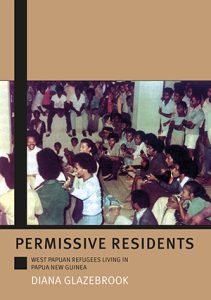Permissive Residents: West Papuan Refugees Living in Papua New Guinea

Author: Diana Glazebrook
Publisher: Australian National University (ANU) Press
Year of Publication: 2008
Print Length: 171 pages
Genre: Non-Fiction / Anthropology
Area: Papua New Guinea, Asia-Pacific, Pacific Oceania
People: West Papuan
Topic: Lived Experience, Refugees & Forced Migration, Refugee Resettlement, Refugee Urban Settlement, Culture & Society, Integration, Indigenous & Indigeneity, Social Justice
This book offers another frame through which to view the event of the outrigger landing of 43 West Papuans in Australia in 2006. West Papuans have crossed boundaries to seek asylum since 1962, usually eastward into Papua New Guinea (PNG), and occasionally southward to Australia. Between 1984–86, around 11,000 people crossed into PNG seeking asylum. After the Government of PNG acceded to the United Nations Convention and Protocol Relating to the Status of Refugees, West Papuans were relocated from informal camps on the international border to a single inland location called East Awin. This volume provides an ethnography of that settlement based on the author’s fieldwork carried out in 1998–99.
Table of Contents
List of Illustrations
Acknowledgements
Glossary
Prologue: Intoxicating flag
1. Speaking historically about West Papua
2. Culture as the conscious object of performance
3. A flight path
4. Sensing displacement
5. Refugee settlements as social spaces
6. Inscribing the empty rainforest with our history
7. Unsated sago appetites
8. Becoming translokal
9. Permissive residents
10. Relocation to connected places
11. Being ‘indigenous’ in the Indonesian province of Papua
Coda: Forty-three West Papuans arrive in Australia by outrigger canoe, 2006

Diana Glazebrook is from the Australian National University, ANU College of Asia and the Pacific and the Assistant Editor of Asia Pacific Journal of Anthropology and the Journal of Pacific History. In 1998-99, she undertook fieldwork among West Papuan refugees in PNG towards a PhD in Anthropology (ANU). In 2003–4, while a post-doctoral research fellow at the Centre for Cross-Cultural Research at the ANU, she carried out fieldwork in Dandenong, Melbourne, to look at the resettlement strategies of Hazara people from Central Afghanistan, released from detention on temporary protection visas, and in Iran, from where Hazara asylum seekers were making secondary movement to Australia. More recently, she worked with Seeds of Life researchers in Timor-Leste to use qualitative social research methods to investigate cultural aspects of subsistence farming, and collaborated with Timorese researchers to examine health care-seeking behaviours across Timor-Leste for a UNSW study.
Source: https://anu-au.academia.edu/DianaGlazebrook
More from Diana Glazebrook in this library, click here.
